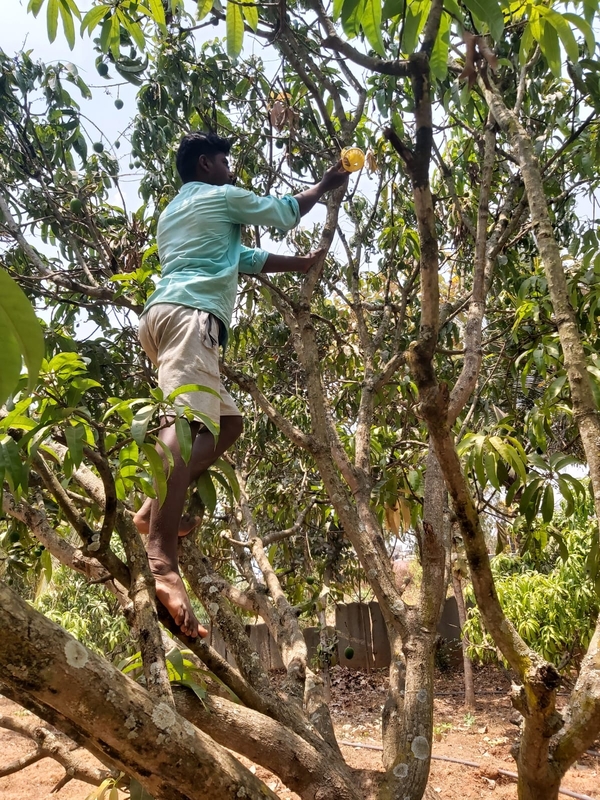Coppersmith Barbet's calling in Bangalore, India

It’s early spring and the days are warming fast in Bangalore, India. Along with the warmth comes the call of the Coppersmith Barbets (Megalaima haemacephala) from the remaining mature trees in our urban areas. If you listen to the video embedded in the story you can hear their raucous call which starts from 5 am in the morning during the breeding season. The call is shrill and continuous and can be quite disturbing if in close proximity.
Copy paste the link below to hear its call!
https://www.youtube.com/watch?v=6IpU_dLropY
The Coppersmith Barbet likes open wooded country and urban gardens and is hardly found in dense forest. They are found in India, Pakistan, Nepal, Bangladesh, and Sri Lanka to SW China, Malaysia, Sumatra and the Philippines. In India they are widely spread across the entire country.
A decade ago when I used the gym in the club, I could watch these beautiful birds fly in and out of a cavity made in a Jacaranda tree branch. It was a sad day when the club decided to cut the tree down to make way for a covered swimming pool.
These birds are frugivores and live mainly on a diet of fruit. There are many wild fruit trees in south and southeast Asia, so they can feast on a range of foods, including figs, guavas, mangoes and berries. They occasionally eat insects, larvae and the petals of flowers.
Coppersmith barbets are a non-migratory, and are mainly lowland species occurring in well-wooded areas but also readily utilizing man-modified habitats like gardens, orchards and other cultivated land where there are fruiting trees.
The breeding season is mainly from February to April in India. Both sexes excavate the nest on the underside of a narrow horizontal branch and they also roost inside the nest holes. The female lays a clutch of three or four eggs.It is predominantly frugivorous, but has been observed eating insects, especially winged termites.
The Coppersmith barbet lives solitary or in small groups; larger parties have occasionally been sighted in abundantly fruiting Ficus trees. It appears to be fond of sunning in the morning on bare top branches of tall trees, often flitting about to sit next to each other. Its flight is straight, with rapid flaps.
It competes with other cavity nesting birds and frugivores. Blue-throated barbets have been seen evicting coppersmith barbets from their nest holes, while red-vented bulbuls have been seen to indulge in kleptoparasitism, robbing the male of berries brought to the female at the nest.
The nest holes are also used for roosting and some birds roost alone in cavities and these often roost during part of the day. Immatures will roost with the parents but often return to roost early so as not to be prevented by the parents from entering the roost cavity.
Copy paste the link below to hear its call!
https://www.youtube.com/watch?v=6IpU_dLropY
The Coppersmith Barbet likes open wooded country and urban gardens and is hardly found in dense forest. They are found in India, Pakistan, Nepal, Bangladesh, and Sri Lanka to SW China, Malaysia, Sumatra and the Philippines. In India they are widely spread across the entire country.
A decade ago when I used the gym in the club, I could watch these beautiful birds fly in and out of a cavity made in a Jacaranda tree branch. It was a sad day when the club decided to cut the tree down to make way for a covered swimming pool.
These birds are frugivores and live mainly on a diet of fruit. There are many wild fruit trees in south and southeast Asia, so they can feast on a range of foods, including figs, guavas, mangoes and berries. They occasionally eat insects, larvae and the petals of flowers.
Coppersmith barbets are a non-migratory, and are mainly lowland species occurring in well-wooded areas but also readily utilizing man-modified habitats like gardens, orchards and other cultivated land where there are fruiting trees.
The breeding season is mainly from February to April in India. Both sexes excavate the nest on the underside of a narrow horizontal branch and they also roost inside the nest holes. The female lays a clutch of three or four eggs.It is predominantly frugivorous, but has been observed eating insects, especially winged termites.
The Coppersmith barbet lives solitary or in small groups; larger parties have occasionally been sighted in abundantly fruiting Ficus trees. It appears to be fond of sunning in the morning on bare top branches of tall trees, often flitting about to sit next to each other. Its flight is straight, with rapid flaps.
It competes with other cavity nesting birds and frugivores. Blue-throated barbets have been seen evicting coppersmith barbets from their nest holes, while red-vented bulbuls have been seen to indulge in kleptoparasitism, robbing the male of berries brought to the female at the nest.
The nest holes are also used for roosting and some birds roost alone in cavities and these often roost during part of the day. Immatures will roost with the parents but often return to roost early so as not to be prevented by the parents from entering the roost cavity.

Related Articles
Editor's Picks Articles
Top Ten Articles
Previous Features
Site Map
Content copyright © 2023 by Marianne de Nazareth. All rights reserved.
This content was written by Marianne de Nazareth. If you wish to use this content in any manner, you need written permission. Contact Marianne de Nazareth for details.





 -resizeimage.jpg.jpg)

